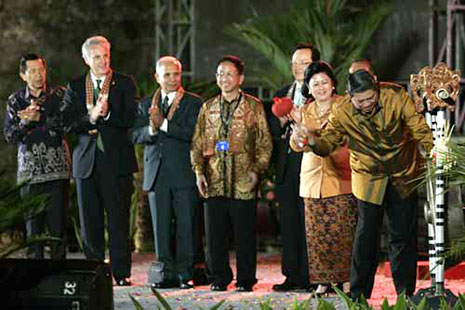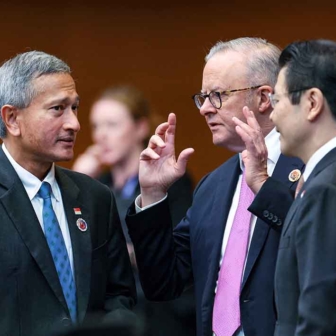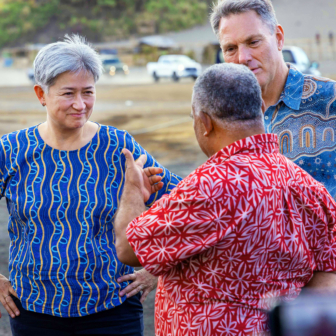ON A BALMY NIGHT in August this year the president of Indonesia opened the largest regional AIDS conference yet held in Asia. In his speech, little reported in the Australian media, Susilo Bambang Yudhoyono welcomed the partnership and bravery of “positive women; people living with HIV; survivors of injecting drug use; sex workers; and the network of gay, transgenders and men who have sex with men.”
It’s worth remembering that at the large UN General Assembly debates on AIDS in 2001 and 2006 the very acknowledgement of those most vulnerable to HIV – and certainly the use of terms such as sex work, gay and transgender – was among the most controversial issues, with Islamic states, the Catholic church and the Bush administration all opposed to recognising these groups. AIDS remains a disease marked by enormous stigma, which in turn means that prevention and treatment efforts are constantly stymied by moralism triumphing over realism.
The popular image of the epidemic counterposes a controlled and small epidemic in rich countries, largely confined to homosexual men and needle users, with a much larger one, usually identified with women and children, in poor countries. In some ways this is an accurate picture, because the sheer number of infections in sub-Saharan Africa means they account for perhaps 70 per cent of all HIV cases in the world. In many communities in countries like South Africa, Botswana and Zambia, one in four young adults will be positive, and this is reflected in death rates and in large numbers of orphans.
But the realities are somewhat more complex. The fastest-rising epidemics include those among drug users in the former Soviet Union and homosexual men in southeast and east Asia. Both are populations that have been stigmatised by governments and ignored in prevention programs. A reluctance to talk honestly about human behaviour has meant real distortions in public health messages, which are often directed at low-risk but politically safe targets such as “youth.”
It is true that outside sub-Saharan Africa, AIDS has not turned out to be the massive pandemic predicted in the 1990s. In our part of the world there are significant increases in Papua, both east and west, and among specific populations, especially injecting drug users and men who have sex with men. In absolute numbers India, and perhaps China, have potentially major epidemics. In China, according to UNAIDS, the United Nations agency, “The number of people who have a high risk of exposure to HIV could be 30–50 million: mainly injecting drug users and their sexual partners, sex workers, their clients and partners as well as men who have unprotected sex with men.” But UNAIDS reports that there are “currently no signs of a generalised epidemic in the country” and the Chinese government “aims to keep HIV estimates below 1.5 million in 2010.”
Globally, HIV infections are rising two to three times faster than the numbers of people who have access to treatments, and this is true even in middle-income countries, such as Thailand, with good access to antiretroviral drugs. AIDS is both a product and a cause of global links. Its spread grows out of existing inequalities and injustice: apartheid in South Africa; civil conflict and the collapse of the state in Rwanda and Kenya; poor governance in Zimbabwe. In some countries HIV/AIDS is clearly a further burden on already overstretched social, economic and political structures. At the same time it is the major cause of premature death in increasing numbers of countries, striking most at infants born to HIV-positive mothers and young adults in the most productive years of their lives. A whole generation of AIDS orphans is developing across many parts of the poor world, leaving children growing up in societies in which only they and the old people remain.
The epidemic reverses development: it involves the loss of skilled labour, a decline of industrial and food production, the collapse of family structures and greater stress on social and health services. Its direct political impact is less obvious, although in some African countries there appears to be evidence of a “hollowing out” of institutions, as governing elites become sick and die. There is also a psychocultural impact: mass deaths and illness will trigger a set of irrational responses, such as anger, denial and scapegoating. Because such effects are hard to measure, and are politically sensitive, most of those who work on the epidemic have been reluctant to explore fully the ways in which AIDS reshapes those who are most affected; but there is a also rich store of personal, literary and cinematic responses to the epidemic.
HIV is now attracting far less global attention than it did in the beginning of the century. More conventional threats – especially those associated with nuclear proliferation and terrorism – and the twin spectres of financial crisis and climate change have taken centre stage. This does not mean that the threat of HIV is less urgent; indeed, the decline of attention has the potential to make it all the more significant.
It is the nature of non-traditional threats to security that they tend to compound each other. Climate change is closely linked to problems of food and water security, which in turn will increase vulnerability to a number of diseases. This is less obvious in relation to HIV than to waterborne infections and malaria, but any increase in impoverishment will make it more difficult to maintain antiretroviral therapies. There is already ongoing research, supported by UNAIDS and the UN Environment Programme, examining the connections between the two crises, although the links seem at this stage to be indirect.
The greater threats may well come from the interaction of traditional security threats, especially when they lead to massive dislocations of people, as is now happening in parts of Pakistan and Afghanistan. So far research on HIV in Pakistan has pointed to small rates of infection among the groups usually regarded as most vulnerable, and called for further outreach to marginalised communities. But the massive dislocations occurring because of civil conflict, and the increasing disruption to traditional communities and ways of life, all create the conditions for more commercial sex and drug use among people who are not likely to feel any kinship with identity-based organisations.
The combination of political instability, climate change, food and water shortages and increasing and uncontrolled movements of people all work against effective HIV prevention and treatment. None in themselves are causes of the spread of the epidemic, yet the ways in which they draw attention away from HIV prevention and care increase the chances of the epidemic continuing to grow.
The move to conceptualise HIV as a security issue dates back to the early 1990s, and emerged as much from a political desire to place it higher on the political agenda as from an analysis of its impact on global stability. There is evidence that officers in the CIA had been urging their superiors to consider the impact of HIV/AIDS on national and international stability since the late 1980s. This view was expressed in several high-level reports, including a study compiled jointly by the Chemical and Biological Arms Control Institute and the Center for Strategic and International Studies, which claimed to “directly link health and global security for the first time.” The report stressed the rapidity with which infections can spread, the threat of biological weapons and the consequences for health of regional conflicts and failing states.
The linkage between HIV and security was taken up publicly by the United States at the end of the Clinton presidency. Largely as a result of American pressure – particularly the efforts of Vice President Al Gore and Ambassador Richard Holbrooke – the issue found a place on the agenda of the UN Security Council. In its resolution the Council stressed that the pandemic, “if unchecked, may pose a risk to stability and security,” and referred to the ways in which “conditions of violence and instability” increased the risk of exposure to HIV. The following year the General Assembly devoted a special session to the issues of HIV/AIDS and spoke of the epidemic, especially in Africa, as “a state of emergency which threatens development, social cohesion, political stability, food security and life expectancy, and imposes a devastating economic burden.”
The sense of HIV as a major security issue also underlay some of the rhetoric that surrounded the Bush administration’s massive commitment of funds to HIV treatments and, on a smaller scale, prevention. To some of its critics the President’s Emergency Plan for AIDS Relief was just another example of American determination to exercise global domination. But this view probably underestimates the extent to which altruism was a major factor in US policy making – indeed, AIDS might be seen as an almost paradigmatic case of the American desire to “do good.” Despite its imperfection – the emphasis on abstinence education; the hostility to working with sex workers; the support for US-produced pharmaceuticals – the Bush program has undoubtedly saved lives. One study from Stanford suggests that the program has averted 1.2 million deaths and in its first four years (2003–07) had cut the HIV/AIDS death toll by 10.5 per cent in targeted countries.
A failure to continue this funding, which is possible if the United States makes major budget cuts in coming years, would be tragic. Unlike its predecessors, the most recent conference of the G8 industrialised countries failed to make any specific commitments to meeting the target of universal access to treatments for HIV by next year, one of the specific pledges in the UN’s Millennium Development Goals.
The other part of the MDG promise was to “halt and begin to reverse the spread of HIV/AIDS” by 2015, and the fiercest debates now going on within the AIDS world are about the intersections of treatments and prevention. Some medicos are attracted to the idea of “treatment as prevention” – in other words, if everyone who might be infected is tested and where necessary put on antiretroviral drugs, the overall infection rate would fall dramatically. The sheer practical difficulties of doing this in many parts of the world raise deep concerns about whether it is an effective replacement for the more complex programs – peer education, providing condoms and clean needles, and attempting to change sexual cultures – that accompany the successful behavioural interventions that have limited the spread of HIV among many groups internationally.
Part of the attraction of the “treatment as prevention” approach is that it hands control to the medicos and avoids the bitter moral arguments that have bedevilled so many programs directed at groups seen as deviant and immoral. Yet in both rich and poor countries there have been remarkable successes in lowering infection among sex workers, homosexual men and drug users where appropriate information and resources are made available.
If the prejudices and barriers thrown up in the name of religion, culture and tradition can be overcome, preventing HIV is not that difficult. The major obstacle comes from fundamentalists who preach against condoms and needle exchange in the name of morality, a key issue in parts of Papua New Guinea.
This is why the honesty in President Yudhoyono’s August speech was so significant. Only when governments, churches and international organisations are able to accept the diversity of human behaviours without imposing ideological strictures will a successful set of global prevention programs be able to halt the spread of HIV. •




